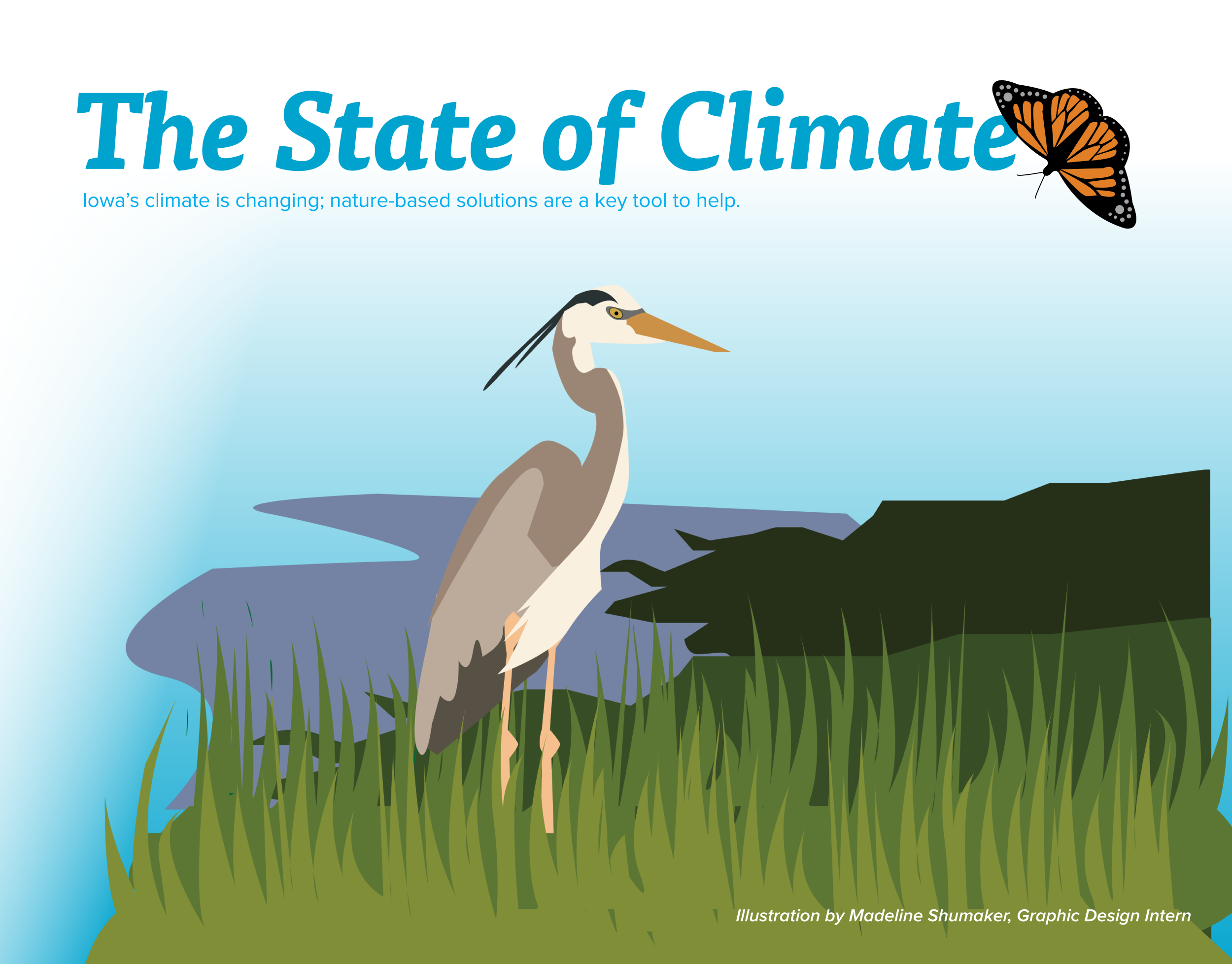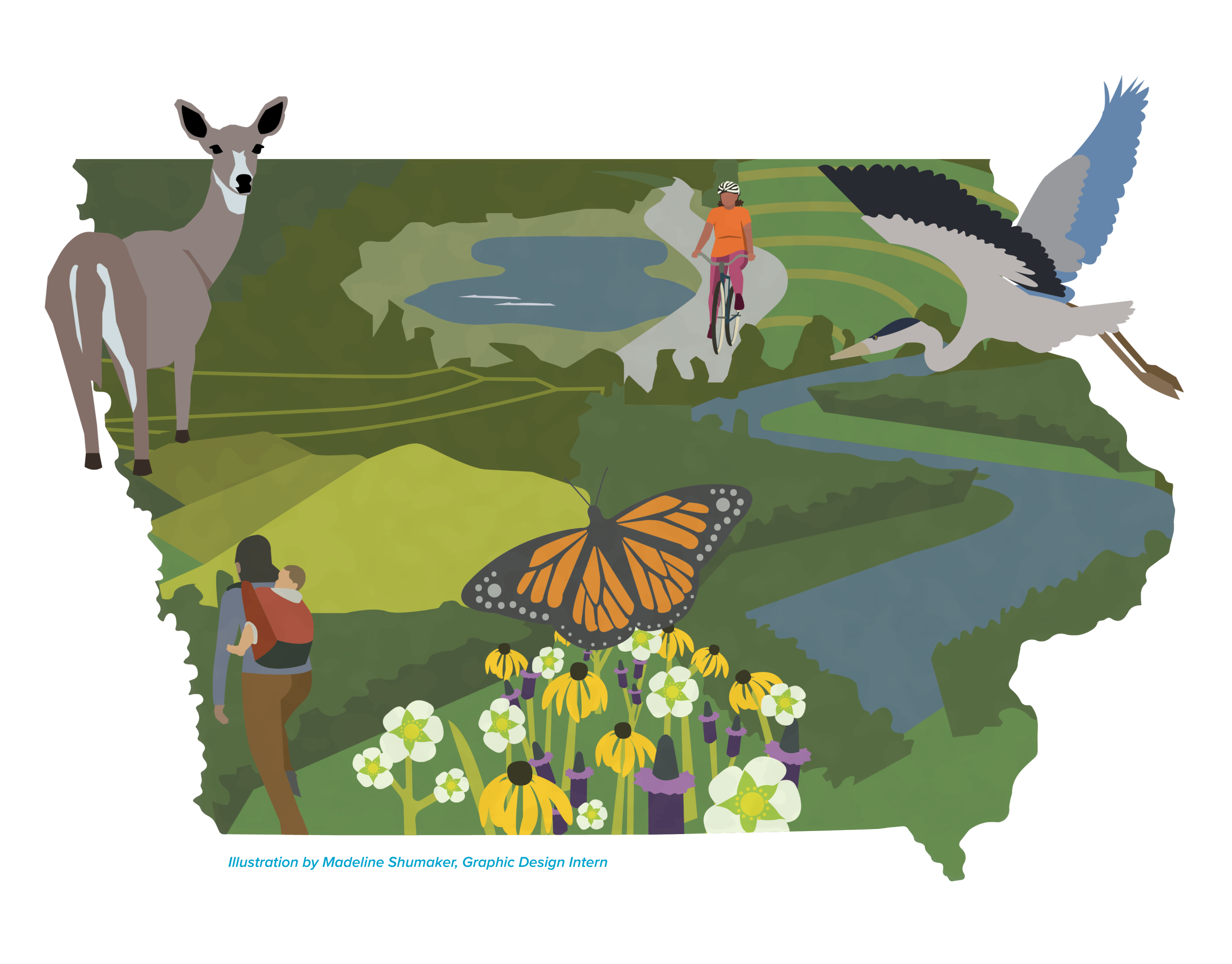The State of Climate
By Emily Martin on July 13, 2023 in Blog

When most people think of climate change, images of melting ice and polar bears spring to mind. It makes the issue feel distant, as though it will always happen to someone else but never come to our landlocked state. Iowa doesn’t have glaciers to melt, but we’re still facing very real issues because of the advancing climate crisis. Rural bridges and roads that wash out because of overwhelming rain events. Loss of wildlife diversity once so abundant it inspired novels. It is undeniable that Iowa’s climate is already changing.
It can be overwhelming to know where to begin to tackle Iowa’s climate emergency. The last time Iowa created a comprehensive publicly-funded climate report was in 2011. Since then, Iowa has lost $20 billion to $50 billion to natural disasters (NOAA National Centers for Environmental Information). There is urgency in acting now on both a statewide and individual level. Despite the scale of the issues Iowa is facing, there is hope.
Fighting climate change starts with understanding what we know has changed and reliably predicting what we know will change moving forward. INHF is proud to be publishing the Iowa Climate Assessment, being written voluntarily by several of Iowa’s top climate scientists. Dr. Gene Takle, professor emeritus of Iowa State University and lead author of the Iowa Climate Assessment, explains more.
What’s Happening in Iowa?
Courtesy of Dr. Gene Takle | Reviewed by the Iowa Climate Assessment lead authors
We usually associate the term “climate change” with hotter conditions. And, in fact, at the global scale, higher temperatures during the planet’s warm seasons are, indeed, becoming more frequent. The latest international report, compiled and agreed upon by thousands of scientists from over 195 nations, found that 43 of 45 global land regions are experiencing more extreme heat events.
But Iowa is not in one of these 43 regions. Over the 20th century Iowa’s average temperature increased by only 0.2 °F, and over the last 30 years the average rose by 0.8 °F from the 20th-century average — far less than the global temperature rise of over twice as much, 1.9 °F. A closer look reveals that our daily maximum temperatures in summer have actually gone down over the last 30 years by 1.1 °F. Of course, most Iowans think our summers are already hot enough, so this observation sounds like good news. But there’s more to the story.
Iowa is getting wetter. Weather records confirm this and further reveal that the statewide rainfall in the April-May-June period now has gone up by 2.4 inches over the same 3-month period in the 20th century. For comparison, this excess rain, averaged over the entire state of Iowa, is enough to fill an empty Lake Red Rock (Iowa’s largest lake) 36 times every year.
Not only that, but 4 and 6-inch-per-day rains have become much more frequent. Also, summer nights feel warmer and more humid, and winters seem warmer with fewer days below, say, -15 °F. Overall, there seems to be more weird weather. Throw in an occasional flood, derecho, -30°F wind chill, and severe drought, and we are prompted to ask, “Is this climate change?” Are these a part of natural variations in Iowa’s weather or are they caused by changing conditions outside of our state? What are the impacts of these and future changes?
The Iowa Climate Assessment, to be completed by a team of Iowa scientists in 2024, will be an extensive collection of scientific literature on Iowa climate and how its trends, variability and extremes have been changing and will affect future water resources, natural systems, agriculture and human health. It also will address climate adaptation and mitigation, including the unique opportunities and challenges posed by Iowa’s future climate.
The path forward
As a conservation organization, INHF is deeply concerned by the changes we’re seeing on the land. In a state already more altered than nearly any other in the country, we cannot afford to lose more of our natural resources that help mitigate climate change impacts. That’s why we’re taking action in partnership with private landowners and other conservation organizations to protect and restore land. Every acre protected or restored is another acre resilient to change. To floods and droughts. To temperatures inhospitable for playing or working outdoors.
Land protection and restoration have a significant role to play in preventing and mitigating climate change. According to a study published by Proceedings of the National Academy of Sciences of the United States of America in 2017, “nature-based solutions can provide up to 37% of the emission reductions needed by 2030 to keep global temperature increases below 2°C.” Those nature-based solutions include reforestation, wetland restoration, rotational grazing and many other conservation practices. Agriculture is also part of the solution; if cover crops and no-till were implemented in every one of Iowa’s agricultural fields, we could offset 18% of Iowa’s total greenhouse gas emissions. These land-based climate solutions can be broken down into four main benefits.

Removing air pollution through land protection
The term “carbon sequestration” is often used when discussing climate change. Sequestration is another way of saying the long-term storage of carbon in plants, soils, geologic formations, and oceans, which is the natural cycle of carbon. As humans have interrupted the natural cycling of carbon, it’s become necessary to restore these natural carbon absorbers. In Iowa, we look to plants and soils to absorb and hold that carbon. Prairies, forests, wetlands, and cover crops on agricultural land are all solutions to remove carbon from the atmosphere and hold it in place.
Preventing pollution of air and water
Conservation on the land can both help absorb greenhouse gases like carbon and prevent their emission. When a forest is clear-cut, a prairie is plowed, or a wetland is drained and paved over, much of the carbon is transferred to the atmosphere which further contributes to the climate imbalance. By protecting land long-term, INHF is making sure carbon stays where it is held by ecosystems – in plants and the soil. One of the best and most immediate actions INHF, landowners and other conservation organizations can take for climate change is to protect Iowa’s native ecosystems so more carbon is not lost.
Providing habitat for wildlife
Just as humans need corridors to travel, interconnected landscapes are a key resource wildlife species currently need and will need as changes to their home range could force them to new areas. Wildlife already does not have many places to move in the state, so protecting areas where they can freely wander and adjust to impacts, such as river corridors or large tracts of forest or prairie, will be crucial to their survival.
Building resilient communities
Land protection and restoration also creates resilient communities. As Iowa faces increasing extreme weather events, our native ecosystems will help protect us. For example, when we receive more than average rainfall, wetlands and deep-rooted prairies upstream will help absorb that water before it enters rivers and streams to prevent flooding downstream. At the same time, that water is being cleaned of pollutants like nitrate.
To do our part in addressing climate challenges, we all must lean into what we love and let that drive our actions. For you, that may be creating a livable and thriving world for your children and grandchildren. For INHF, we are driven by our love of Iowa’s land, water and wildlife. Together, we can take collective action and create a better world for future generations.